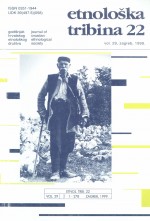Tragovi bunjevačkih elemenata u svadbenim običajima Like i Primorja: Svatovska čast kuma
Traces of the Elements of Bunjevci-Croats in Wedding Customs of Lika and Primorje: Wedding Honor of the Best Man
Author(s): Milana ČernelićContributor(s): Snježana Ivanović (Translator)
Subject(s): Customs / Folklore, Cultural Anthropology / Ethnology, Family and social welfare, Ethnic Minorities Studies
Published by: Hrvatsko etnološko društvo
Keywords: wedding customs; Bunjevci; Lika; Primorje;
Summary/Abstract: Contrary to the previous research only field research in the nineties confirmed that best man with Bunjevci-Croats from Primorje and Lika has the role of wedding chief and that he is the first in honor among other honorable. The characteristic of Bunjevci-Croats’ honour of the best man is his role as the guard of the young bride, as well as different kinds of relationship of best men and godfathers. Besides, specific elements of such his role have been identified and determined, which are in fact the expression of paying homage to the best man: obligation of the families of bride and bridegroom to first invite the best man to the wedding, ceremonious departure to pick up the best man on the day of the wedding, escorting the best man and ceremonious conduct with presents during specific time after the wedding. All considered elements of the best man’s role are just some of the more significant traces of Bunjevci-Croats’ elements in wedding customs of Lika and Primorje. It is relative to the region of Pazarište, Sv. Rok and Ribnik in southern parts of Lika. Some of these elements were identified in the previous research in Krmpote and Krivi Put in the hinterland of Senj. The most recent research in 1999 confirmed them in Krivi Put and in the district of the municipality of Stolac in the Podgorje in Northern Velebit (under Senjsko Bilo). Wedding honour of the best man is considered from a wider perspective of the research of certain phenomena in Bunjevci-Croats’ wedding customs, which are starting points for identifying the ethnogenesis of Bunjevci-Croats. Therefore, in the concluding part of the article these elements of the best man’s role are put within the wider context of Southeast Europe. Their arrangement in the space and correspondences with Roman and Romanized groups in the Balkans indicate rearrangement of indigenous and Slavonic cultural elements in the South-Adriatic border area, as well as their later spreading towards west and north, where the final points of their appearance are the areas settled by Bunjevci to the west (Lika and Primoije) and to the north (Podunavlje).
Journal: Etnološka tribina : Godišnjak Hrvatskog etnološkog društva
- Issue Year: 29/1999
- Issue No: 22
- Page Range: 37-46
- Page Count: 10
- Language: Croatian

